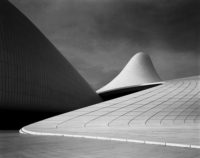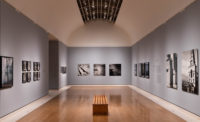The second edition of the Collective design fair takes place this weekend in Manhattan. This year, the fair—founded by architect Steven Learner—has set up shop in the atrium at the McKim, Mead & White-designed Farley Post Office in Manhattan and added 19 additional galleries to its roster. One of the newcomers, German dealer Gabrielle Ammann, is offering work by Zaha Hadid, Wolfs + Jung, Satyendra Pakhalé, and several others—including an impressive table by Studio Nucleo—but among the highlights of her booth are 10 prints by architectural photographer Hélène Binet.
Binet, who was born in Switzerland and raised in Italy, moved to London in the late 1980s. There, she began photographing architecture with what became her particular style. She has an eye that seizes on details and frames experiential moments, privileging poetry and evocation over explanation or representation. She has gone on to photograph work by some of the most significant architects of her generation as well as historical subjects. The selection at Collective draws from her studies of the London architecture of Nicholas Hawksmoor, shown two years ago at the Venice Architecture Biennale, and a series focusing on “portraits” of Hadid’s MAXXI museum in Rome, as well as work by Le Corbusier and Peter Zumthor.
RECORD spoke with Binet about the work on view, how she approaches her practice, and the relationship between photographer and architect. This fall, her work will also be featured in Constructing Worlds: Photography and Architecture in the Modern Age at The Barbican in London, September 25, 2014-January 11, 2015.
The Collective 2 design fair runs May 8-11 in New York City.
Several of the photos that Ammann//Gallery is showing at Collective come from your series about Nicholas Hawksmoor, and in particular his work from the early 18th century that revive classical motifs. Why did you begin photographing that work?
I grew up in Rome, so historical architecture has always been important to me. Hawksmoor, in particular, is a haunting character in London. He is tucked into the city. You almost touch his work everywhere. Everybody knows it, but not very well. I really wanted to bring out that ghostly, strange, fantastic presence by shooting it in black and white and focusing on details.
Hawksmoor had an interest in Antiquity, but he never visited Greece and Rome. Instead, he studied them a lot in engravings. I wanted to add another layer to that. Maybe he had this dream about classical architecture that he had never seen. It was the same for me, playing with things that belong to him.
How does your approach change when you’re shooting contemporary architecture, such as Zaha Hadid’s MAXXI museum?
I think with the MAXXI there is a sense of making a portrait of it. I’ve been creating creating family portraits of Hadid's buildings. I’ve taken images of each of them where they look like characters sticking out against a neutral background. They have a bit of anthropomorphic feeling—or they look like birds.
The feeling of the architecture is very difficult to convey, so I try to be very reduced in what I say. I find her buildings have a sense of endlessness, and they’re very difficult to photograph. You deal with this almost natural force with her work, like when you’re photographing a landscape or the sea—every form then creates a new one. I wanted to capture moments in that process with these portraits, punctuations, a break. I need to make them simple but stunning.
It’s the moment that’s special for me. It belongs to the space. I try not to show too much of the space. The rest of it has to belong to you. You ask what is happening there, and you’re not sure, so you make your own experience.
Is that a strategy you take with your work in general?
It’s very important that I don’t say too much about the building—that I let you come into it. When you have a very big, wide-angle, descriptive image, you are pushed out. I want you to enter by starting to imagine things.
I try somehow to guide you to the world that belongs to the architect. It’s like a musician who has a score.















Post a comment to this article
Report Abusive Comment